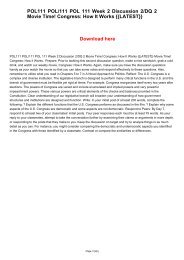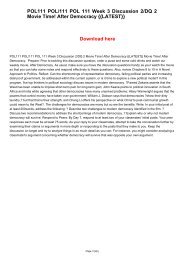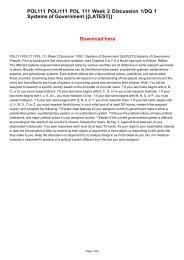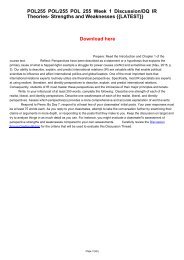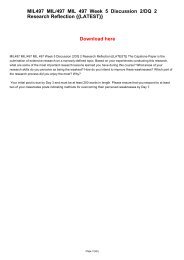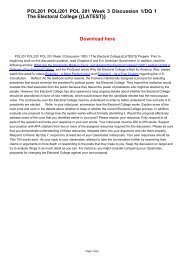MAT 126 MAT126 MAT126 Week 5 Discussion 1DQ 1 Week Five Discussion {{LATEST}}
- No tags were found...
You also want an ePaper? Increase the reach of your titles
YUMPU automatically turns print PDFs into web optimized ePapers that Google loves.
<strong>MAT</strong> <strong>126</strong> <strong>MAT</strong>/<strong>126</strong> <strong>MAT</strong><strong>126</strong> <strong>Week</strong> 5 <strong>Discussion</strong> 1/DQ 1<br />
<strong>Week</strong> <strong>Five</strong> <strong>Discussion</strong> {{<strong>LATEST</strong>}}<br />
Download here<br />
<strong>MAT</strong> <strong>126</strong> <strong>MAT</strong>/<strong>126</strong> <strong>MAT</strong><strong>126</strong> <strong>Week</strong> 5 <strong>Discussion</strong> 1/DQ 1 <strong>Week</strong> <strong>Five</strong> <strong>Discussion</strong> {{<strong>LATEST</strong>}} This <strong>Discussion</strong> will give you<br />
the opportunity to calculate or identify the three measures of central tendency. You will be asked to select an appropriate<br />
real life situation in which one measure would be more appropriate than the other two measures of center.<br />
1. Select a topic of interest to you and record the topic in your posting, for example: What is the average number of<br />
hours people watch TV every week? Make sure the question you ask will be answered with a number, rather than<br />
answers with words. 2. Write a hypothesis of what you expect your research to reveal. Example: Adults 21 years and<br />
over watch an average of 2.5 hours of TV per day. 3. Sample at least fifteen people and record their data in a simple<br />
table or chart; study the examples from Section 12-3. 4. You can gather your data at work, on the phone, or via some<br />
other method. This is your Sampling Design. Which of the four sampling techniques best describes your design? 5.<br />
Explain in moderate detail the method you used to gather your data. In statistics this venture is called the Methodology.<br />
6. Make sure you break your sample into classes or groups, such as males/females, or ages, or time of day, etc. 7.<br />
Calculate the mean, median, and mode for your data as a whole. 8. Now calculate the mean, median, and mode of<br />
each of your classes or groups. 9. Indicate which measure of central tendency best describes your data and why.<br />
Then compare your results for each class or group, and point out any interesting results or unusual outcomes between<br />
the classes or groups. This is called a comparative analysis using our results to explain interesting outcomes or<br />
differences (i.e., between men and women). 10.Comment on at least two of your classmates postings. Make sure you<br />
comment on their hypothesis (topic), their design, and whether you agree or do not agree with their best measure of<br />
central tendency. Your initial post should be at least 150 words in length. Respond to at least two of your classmates<br />
posts by Day 7.<br />
Page 1/{nb}



